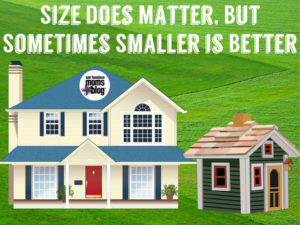 There are so many benefits to living in San Francisco, but residing in small spaces that cost a lot of money is not one of them. A common topic of conversation with our family and friends who don’t live in the Bay Area (we’re transplants) is how big of a house we could get somewhere else, for what we pay here. Compared to the 1,200 square feet that’s housing our family of four, we could easily have 5,000 square feet somewhere else. As I trip over the Matchbox cars in our living room/ family room/ playroom/ everything else room, that does sound tempting. Then, I think, “But that means we’d be living in XYZ, instead of here,” and it loses its appeal.
There are so many benefits to living in San Francisco, but residing in small spaces that cost a lot of money is not one of them. A common topic of conversation with our family and friends who don’t live in the Bay Area (we’re transplants) is how big of a house we could get somewhere else, for what we pay here. Compared to the 1,200 square feet that’s housing our family of four, we could easily have 5,000 square feet somewhere else. As I trip over the Matchbox cars in our living room/ family room/ playroom/ everything else room, that does sound tempting. Then, I think, “But that means we’d be living in XYZ, instead of here,” and it loses its appeal.
Maybe it’s simply out of self preservation and practicality, but I’ve come to love living in a small space because there are some real advantages to it, especially with kids. A neighbor of ours enjoys pointing out how small our place really is, and I take the bait every time. I can’t help but defend our charming, efficient, cozy house. Would it be nice to fit a king sized bed in our master bedroom, so that my 6′ 5″ husband and I don’t have to throw ‘bows at each other all night? Of course, but I know that overall, even with its petite size, our place is great.
I’m not saying we’ll never move, but I am saying that I’ve looked at enough open houses with more square footage to know that space isn’t everything. If you too find yourself defending your living quarters, or if you’re feeling down about where you live, then keep these things in mind.
The Benefits of a Small Space
It’s easier to keep an eye on the kids. I’ve visited plenty of houses where there’s a separate playroom on a different level from the main living area. Do you know where the young kids usually are anyway? Wherever their parents are. I know there comes a time when separate spaces are useful with kids, but for little ones, they’re a waste of space. They want to be near us, not playing alone in another room, as evidenced by the never ending stream of toys migrating into my kitchen. In our tiny house, I can easily see and hear my kids no matter what room they’re in and quickly check on them without climbing a flight of stairs (or fumbling with a baby gate). They’ve still managed to color on the walls, but at least they only got in a few strokes.
We don’t accumulate junk. Before any home furnishing or toy purchase, we have to ask ourselves, “Where is this going to go?” and “Do we have to get rid of anything to make room for it?” That keeps me pretty honest as I stroll through the home decor aisle at City Target admiring the latest Nate Berkus tchotchkes. Sure, a flaked bronze paperweight would add a touch of glitz to any desktop, but do I need it for mine? No, because I don’t even have a desk. There’s no room. Money saved, junk averted.
Clean up is faster. My little Hansel and Gretel do a great job leaving a trail of toys around our tiny home. Between the living room and their bedrooms, I already have enough square footage to clean up. I can’t image also having to pick up a playroom and whatever other rooms a fancier McMansion in the ‘burbs might have.
Don’t get me wrong. I’m not signing up to move into one of those insanely tiny homes that they always show on HGTV. I fully believe there’s a minimum amount of space necessary for a family to live comfortably. What that is depends on the family. Still, it’s a mistake to rule out a place to live based on the size of the rooms alone. Here’s what to consider, instead.
What Makes a Small Space Liveable
Location, location, location. This characteristic of your home can’t be changed, so make it a priority. We’ve toyed with moving out of the city in the past and once met with a strategist at the real estate firm, Suburban Jungle, to learn more about the towns around San Francisco and figure out which one might be a good fit for our family. They wisely advised us that we’d be better served by finding our dream location, rather than searching for our dream home. That discussion actually made us even more motivated to stay put in our tiny home in the city. Living here, with the vibe and amenities that we want, more than offsets our modest square footage.
Look for a smart layout (or the opportunity for a better one, if you’re able to buy and remodel). Would you rather have your kitchen and living room open up to each other, but be smaller overall, or have larger rooms that are totally separate? It’s a personal choice, but in general, for modern family living, an open concept design is much more functional. Because the rooms aren’t closed off, the entire space will feel larger anyway.
Also, keep an eye on how efficiently the space is used. Real estate easily trades for $1,000 a square foot in the city, so we should squeeze every inch of value out of our homes. In contrast, the first time I toured my brother’s new (big) house on the east coast, I was shocked that I could open the door to the powder room all the way, one hundred eighty degrees. It felt so luxurious letting it swing open like that, but was that extra space necessary? Nope. It’s certainly nice to have, and more power to them for having it, but for city living, I’m all for having a door bump into the wall behind it, if it means having an extra closet or added space in the adjoining room.
Look for good storage and good light. If everything has a place to be tucked away, then your actual living area won’t feel as cramped, and if the space is bright, with lots of natural light, it’ll feel more open and inviting than a larger space that’s dim and dark.
Find easy access to outdoor space. Being able to get outside quickly makes a small space feel larger and literally gives your kids extra room to play. The change in scenery from indoors to outdoors will instantly improve their moods (and yours). We’re lucky to have a nice backyard right off of our main living area. It’s proven to be invaluable and has definitely extended our life in this house, but, really, any safe outdoor space for kids will be a huge bonus.
When I told my husband that I was writing this article, he said we’d probably laugh at it a few years from now, after we’ve moved into a larger place. Maybe we will (if we move, that is), but maybe I won’t. I’m not arguing that more space isn’t nice to have, but I don’t think it’s the end all be all. How much room do any of us really need to live comfortably? Even if we did relocate to a town where we could afford to buy a mansion, we wouldn’t get one. Bigger houses mean more stuff, more upkeep, and more money. Living smaller requires living more simply, and there’s real value in that. Size does matter, but sometimes smaller is better.


















We live in Palo Alto and we lived in a 1300 square foot house when my two girls were young. The girls room was right outside the living room. The funny thing is; we moved into a bigger house with a second floor when my younger one was three -and she NEVER has gotten over it yet (she is 9!) She just loved the small space, and falling asleep to the sound of the living room TV and our voices. If you ask her now she would tell you she would move back to the 1300 foot home in a heart beat. I think little kids just feel more secure in a smaller home.
That’s such a great point, Wendie! Kids love to be in small, cozy spaces. I think even adults like it. The most popular room in my parents house is the tiny sunroom.
Yes, less really often is more in many ways, including on the home front!